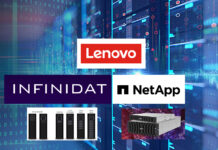Interview. Datadobi’s StorageMAP tool overlaps with the functionality of SyncEngine, VAST Data’s newly announced software to find, catalog, and capture file and object data in other suppliers’ storage or data management systems, and ingest it into VAST’s private, AI-focused universe.
StorageMAP, with its parallelized, multi-threaded, metadata scanning engine (mDSE), scans and lists a customer’s file and object storage environments, both on-premises and in the public cloud, and can then move data between storage tiers and archive cold data, according to policy-driven workflows.
We asked Steve Leeper, Datadobi’s VP of Product Marketing, some questions to draw out the differences between SyncEngine and StorageMAP.
Blocks & Files: Do StorageMAP and SyncEngine cover the same data sources? Where do they overlap or differ?

Steve Leeper: They don’t map the same sources, and they’re not meant to. SyncEngine is a VAST-native capability designed to support onboarding data into the VAST platform, whether for traditional migration or AI ingestion. It’s tightly integrated with VAST’s DASE architecture and optimized for ingesting data that will be processed within VAST’s “AI Operating System.”
StorageMAP, by contrast, is a mature, vendor-agnostic data management platform. It maps data across multi-vendor environments – including NAS, object, and cloud – and provides customers with deep visibility into their entire estate. It’s not just about moving data; it’s about understanding it, cleaning it, and making strategic decisions before migration even begins.
SyncEngine helps you move data into VAST. StorageMAP helps you decide what’s worth moving, and where it should go.
Blocks & Files: Can StorageMAP map VAST Data stored files and objects?
Steve Leeper: Yes. StorageMAP can discover and analyze data stored on VAST just as it does with other platforms. It’s designed to work across heterogeneous environments, including VAST’s architecture, and can provide insights into what’s stored, how it’s used, and whether it’s relevant to retain or migrate.
Blocks & Files: Can StorageMAP feed data to LLMs and AI agents? How?
Steve Leeper: StorageMAP plays a critical role in preparing enterprise data for AI workflows. While SyncEngine can ingest SaaS application data and vectorize it for RAG or inference, StorageMAP can onboard other platform data, especially legacy or multi-vendor sources.
Before any ingestion or training begins, StorageMAP helps clean up the source systems so only relevant, high-quality data is migrated. It identifies ROT (Redundant, Obsolete, Trivial) data and enables policy-driven archiving or deletion. StorageMAP helps ensure that AI models aren’t trained on irrelevant or bad data and that data intended for inferencing or for RAG (retrieval-augmented generation) is appropriate.
StorageMAP doesn’t train your model; it makes sure your model isn’t trained on junk.
Blocks & Files: Can StorageMAP and Datadobi do things SyncEngine cannot?
Steve Leeper: StorageMAP offers:
- Global visibility and mobility across multi-vendor environments
- ROT (Redundant, Obsolete, Trivial) data identification and cleanup
- Policy-driven data movement, archiving, and deletion
- Pre-migration analysis and optimization
- Supports governance, compliance, and sustainability goals
SyncEngine is focused on VAST-centric migration and ingestion. StorageMAP is about strategic data management across the enterprise.
Blocks & Files: What would persuade a VAST Data customer to use StorageMAP rather than SyncEngine?
Steve Leeper: It’s not either/or, it’s complementary. Because SyncEngine and StorageMAP solve different, but interlocking, problems. SyncEngine is a VAST-native tool designed to ingest data into the VAST platform, whether for traditional migration or AI processing. It’s fast, integrated, and ideal for getting data into VAST’s DASE architecture.
SyncEngine assumes you already know what data to move. StorageMAP solves that problem. StorageMAP gives customers visibility into their entire data estate, across vendors, clouds, and formats, so they can identify what’s relevant, what’s ROT, and what’s potentially AI-worthy. SyncEngine doesn’t do that.
StorageMAP enables cleanup, classification, and policy-driven selection before anything touches VAST. That means less junk, lower costs, and better AI outcomes.
In environments shaped by M&A, multi-sourcing, or hybrid cloud, StorageMAP provides the global control plane and massively scalable data plane for mobility. SyncEngine is VAST-specific in terms of being designed to primarily pull data from other sources.
StorageMAP helps surface the right data for RAG and inference workflows from any vendor platform onto the VAST platform. SyncEngine can ingest and vectorize data, but vectorization is an expensive process. Better to use StorageMAP to identify, curate, and migrate the dataset(s) intended for VAST so that downstream processing on the VAST is accelerated.








